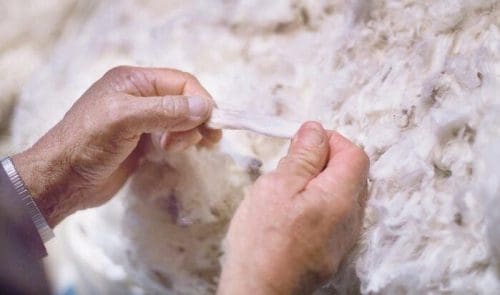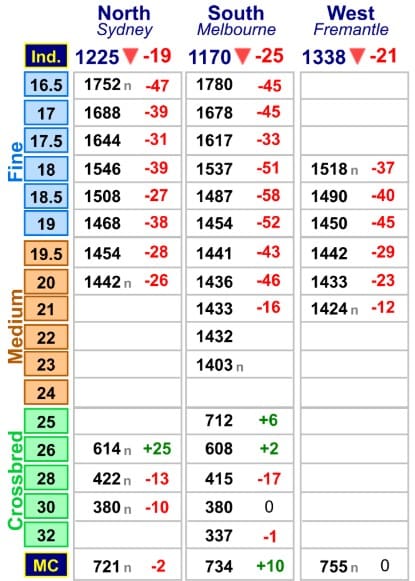 AUSTRALIAN wool prices went against predictions of a dearer auction market this week to record losses across both selling days, ending the strong opening to the 2025 calendar.
AUSTRALIAN wool prices went against predictions of a dearer auction market this week to record losses across both selling days, ending the strong opening to the 2025 calendar.
The Australian Wool Exchange said the higher prices on offer last week encouraged some sellers back to the market, pushing the national offering up to 40,651 bales.
The offering included bales offered in previous sales – about 6.3 percent.
On the first selling day, the benchmark AWEX Eastern Market Indicator dropped by 9 cents/kg clean, ending its run of four selling days of consecutive rises, AWEX said. This was followed by a further 14-cent drop on the second selling day.
The EMI fell by 23 cents for the series, closing at 1192 cc/kg clean.
“This was the highest weekly fall in the EMI since August last year,” AWEX said.
“Although the EMI lost ground this series, it is still trading higher for the calendar year.
“The EMI opened 2025 at 1154c/kg clean, meaning it is 38 cents higher for the year, an increase of 3.3pc.”
AWEX said the softer market was understandably met with seller resistance and the bale passed-in rate rose to 14pc.
“This was the highest passed-in rate since August 2023 when it was 15.3pc.
 “By comparison, during that series the EMI dropped by 36 cents.”
“By comparison, during that series the EMI dropped by 36 cents.”
AWEX said the total value of wool sold continues to track well below that of the previous season.
“Season to date there has been $1,186 million worth of wool sold at auction.
“This is $204 million below last season, a drop of 14.7pc.”
“This falls tracks closely with the overall fall in the national offering, which has reduced by 15.8pc.
However, AWEX said the weaker market has not been a deterrent to growers and next week’s national offering is expected to rise.
There are currently 44,748 bales rostered in Sydney, Melbourne and Fremantle.
Superfine wools struggle without European demand
Australian Wool Innovation trade consultant Scott Carmody said the encouraging signs of last week’s positive market activity quickly dissipated at this week’s auctions.
“The steady prompt demand out of both China and India largely disappeared and European purchasing remains scarce.
“With China again being dominant market buyers, the foreign exchange rates (forex) of the Australian dollar (AUD) against both the Chinese Yuan/Renminbi (CNY) and US dollar (USD) played a very negative role with the cost of that forex now 3.1pc worse for auction sellers locally than it was just 10 days prior,” Mr Carmody said.
“The coupling effect of demand, forex and high volumes of similar supply conspired against any chances of market gains or indeed stability.”
Mr Carmody said a very high percentage of Merino wools on offer this week were in the superfine category of finer than 18.5 micron.
“These wools struggled to achieve any sort of additional competition without the usual historic strong involvement and premiums from European-based operators.
“Unfortunately, this weakness of purchasing intent from our luxury markets coincided with a designated superfine Tasmanian sale offering in Melbourne and subsequently lower clearance rates (86%) were registered nationally, but even much lower clearances were felt in that speciality area of supply.”
Mr Carmody said Australian wool exports from ABS data at the end November 2024 showed China remaining dominant.
“Compared to the same point of last season, China has increased their percentage share by 1.2pc to see 85.8pc going there, even though the total volume exported to China is 8.4pc lower year on year.
Total export volumes are currently running similar to AWTA key test data (-9.8pc) by sitting 9.5pc lower than the previous year,” he said.
“All importing nations for the first five months of the 2024/25 season have seen much lower volumes of Australian wool being imported.
“The largest drop off for our major manufacturers comes from the 31pc less wool that Italy has imported thus far, and concerningly following the 28.8pc drop in imports by Italy for the season prior in 2022/23.,” Mr Carmody said.
“The two dominant trading exporters — almost 30pc of all purchases for the season — led buyers lists again, but were ably supported by the Chinese manufacturers.
“Key indents were missing from the auction this week, after setting the pace within certain types last week.”
Sources – AWEX, AWI.

HAVE YOUR SAY